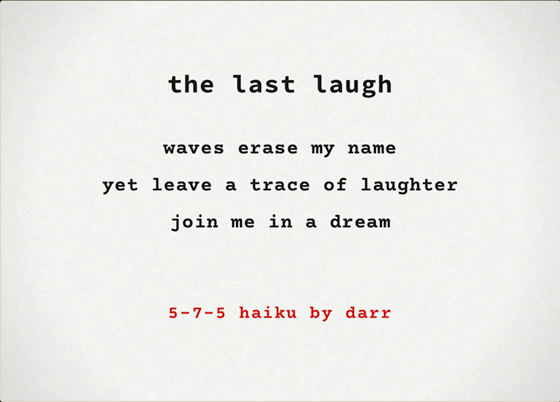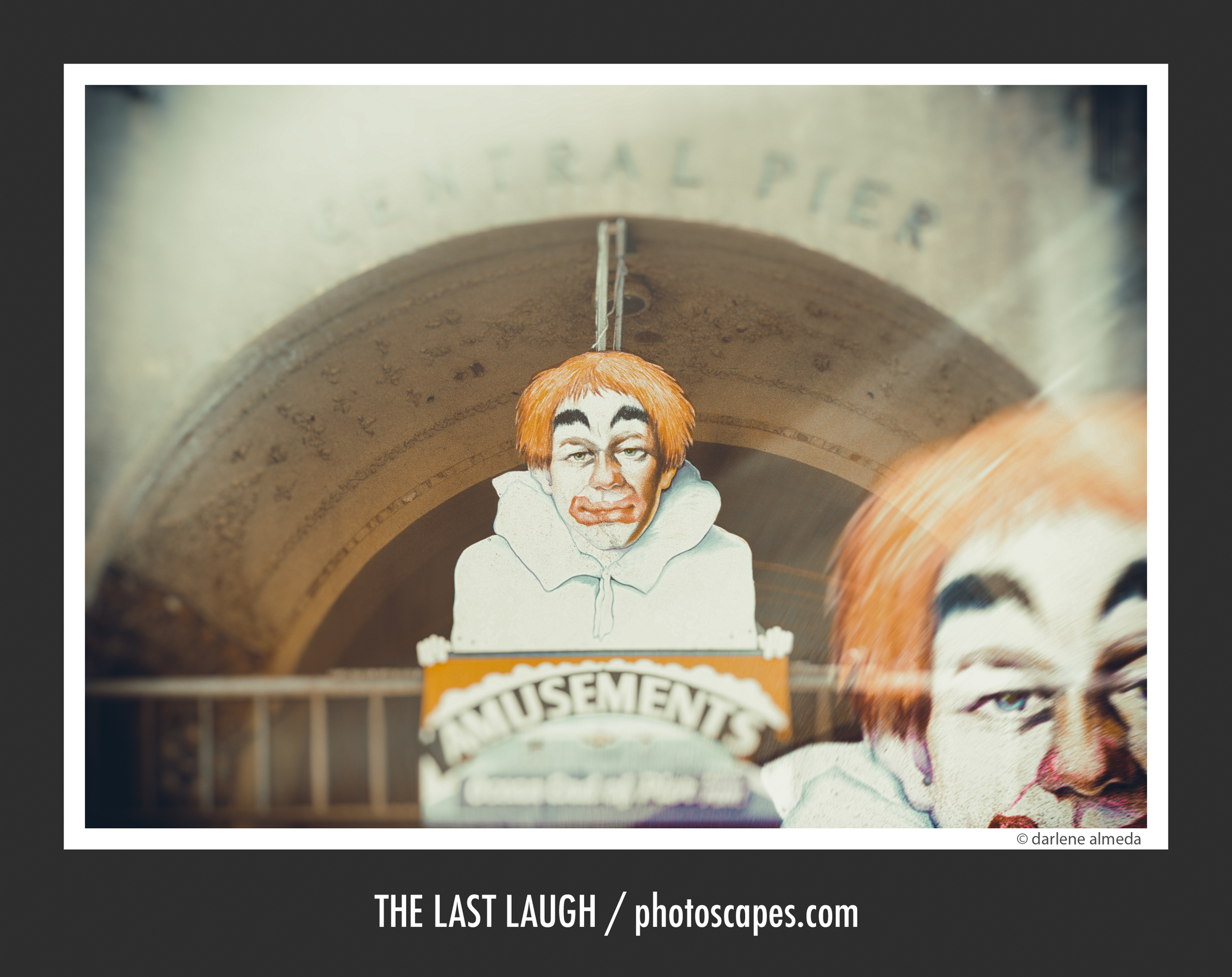Camera: Canon AE-1 Lens: Vivitar S1 70-210/3.5 Film: Kodachrome Dev: Lab Processed
Location: Atlantic City Date: 1984 Lighting: Daylight Genre: Narrative
Each photograph is a frozen moment in time — some joyful, others unsettling, and a few, like this one, unwilling to fade quietly into memory. The Last Laugh began with a rediscovered 1984 slide — a weathered clown sign from the Atlantic City boardwalk. From that small rectangle of film emerged a story about nostalgia, endurance, and how the past still finds its voice within the frame.
The Last Laugh
A Short Story
It was four in the morning, and I couldn’t sleep. My mind wandered to a box of slides I’d recently found among my mother’s keepsakes. I must have left them at her house years ago, and—like the good mom she was—she kept them safe until I claimed them again. Then I forgot about them, tucked away and waiting, until I found them while cleaning out her home after she passed.
Restless, I decided to look through them. Maybe the nostalgia would help me drift back to sleep. I grabbed one of the small plastic boxes, lit up my iPad, and began holding the slides to the screen.
“Oh, these are old,” I said out loud. “1984 old.” Back then, labs stamped the processing date on the film mounts—and sure enough, each one read APR 84. I was young, living in Brooklyn, working at an ad agency by day and attending school at night. On weekends, I’d take the train to my mom’s house, and we’d drive to Atlantic City. We’d walk the boards, have lunch, and visit my grandmother at the nursing home before heading home.
I had my Canon AE-1 in those days—still one of my favorite cameras—and it did a fine job on these slides. Lucky me. There they were: boardwalk scenes of pizza joints, Italian water ice, and glittering casino façades, every frame alive with light and memory. I could almost taste the sweetness of the cherry-red salt water taffy from those afternoons—sticky fingers, seagulls circling, laughter tangled in the wind.
And then, I saw the clown.
Something about that image stopped me. I remembered taking it—aiming the camera upward at an angle, trying to frame it just right—but I hadn’t expected it to still feel alive. The sad eyes, the cracked grin, the sign that once promised joy. It was all there, perfectly preserved in Kodachrome color.
I smiled, feeling both comforted and uneasy. “That’s a sight for tired eyes,” I murmured. “Mr. Sad Clown Face.”
I set the box aside, meaning to look through more later. In a few hours, I’d be on the road again, heading down Florida’s Forgotten Coast for a few days of camping. I took one last look at the clown slide glowing softly on my iPad screen—then turned out the light and drifted off to sleep.
After a few hours of driving along the coast, I found a quiet camping spot. The roof fan and open windows carried in the sound of the sea and the scent of salt. The surf near my camper van was restless that night. I’d parked beside an empty stretch of beach on Florida’s Gulf Coast—the kind of place where the horizon feels endless, and the quiet heavier than it should.
On the small table beside me lay the print I’d made just before leaving—the clown from Atlantic City, smiling his chipped smile beneath the words Central Pier Amusements. I’d taken the photograph decades earlier, back when the boardwalk still hummed with noise and neon.
I studied the image under the weak glow of the van’s lamp, tracing the cracks in his paint, the slight tilt of his head. I remember thinking how strange it was that something meant to be joyful could look so tired. Maybe that’s why the slide stayed hidden all these years—a reminder that laughter fades like everything else. Yet something about it felt different now, unsettling in a way I couldn’t name. It gnawed at me—that image, that expression—as if something beneath the surface wanted to be seen.
The waves outside kept their rhythm, and somewhere between one and the next, I drifted into sleep.
The air changed before I opened my eyes. I could feel it—thicker, cooler, carrying the scent of something sweet, like cotton candy left too long in the sun. A carousel tune drifted through the air, faint but wrong somehow, looping in uneven circles.
When I finally looked around, the van was gone.
In its place stretched the Atlantic City Boardwalk, glowing under a haze of sodium light. The old planks were wet from a mist that didn’t belong to Florida, and every sound—gulls, laughter, footsteps—felt a little too far away, like an echo trying to remember itself.
And then I saw him.
The clown.
He stood beneath the Central Pier Amusements archway—no longer flat and faded on paper, but solid, breathing, impossibly alive. His paint was cracked and flaking, his grin crooked but steady, and his eyes glimmered with something that might have been amusement or a warning.
“Well, well,” he said, voice low and cheerful. “You finally came back.”
The words stopped me cold. I still had my camera—the same old Canon AE-1 from the slides—its leather strap warm against my hand. I tried to laugh, to say something rational, but nothing came out.
He took a slow step forward, boots scraping against the damp boards. “You took my picture once,” he said, tilting his head. “Captured me good, didn’t you? Locked me in that little frame of yours.”
His grin widened—not menacing, not kind. Just too much.
“You photographers,” he continued softly. “Always freezing people. You ever wonder if the pictures remember you, too?”
My pulse quickened. I looked through the viewfinder out of habit, needing a layer of glass between us. The clown was gone. The archway was empty.
But from somewhere behind me came a whisper, warm against my ear.
“Go on,” he said. “Take another. Let’s make this one count.”
The shutter clicked.
And then—silence.
I woke with the sound of waves crashing outside my camper van, heart pounding against the stillness. The lamp was off. The air was thick with salt, and for a moment, I wasn’t sure if I’d dreamed it or brought something back with me.
The horizon outside glowed faintly with early light. Everything was calm again—except for the photograph on my small table. The clown from Atlantic City stared back at me from beneath the words Central Pier Amusements. Only now, the grin seemed a little wider.
I rubbed my eyes and laughed under my breath. “Too much sea air,” I muttered, reaching for the photo.
But when I turned it over, there was a smear of red stickiness on the back—still fresh, like cherry-red salt water taffy glistening in the light of dawn.
The wind picked up, rattling the windows. A wave broke harder against the shore, followed by another.
And in that rush of water, rising and falling, I could’ve sworn I heard a faint, breathy laugh—playful, distant, but not quite gone.
I sat still, listening. The sound faded, replaced by the steady rhythm of the sea.
I don’t know if it was just the wind, but I do know I’ll never look at that photograph the same way again.

Author’s Note: When I first found that old slide of the clown, I didn’t expect it to spark a story—or a sleepless night. Photography has a funny way of doing that: turning small moments into big memories, sometimes with a twist you never saw coming. Every photograph holds more than what’s visible—sometimes it’s memory, sometimes imagination, and sometimes a voice from the past that still wants to be heard. If this story made you smile or shiver, then the clown and I have both done our jobs. Even as an adult, my mom would send me boxes of salt water taffy to enjoy—a sweet reminder of home and of her. I miss her dearly.

